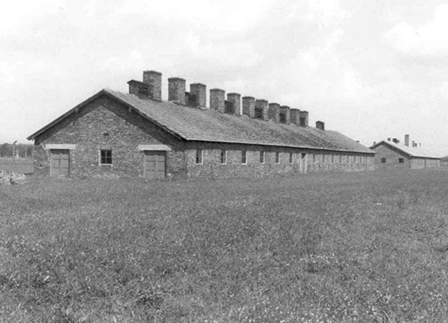- Caption
- A group of elderly survivors preparing food at the Hadamar Institute.
The photograph was taken by an American military photographer soon after the liberation.
- Photographer
- Troy A. Peters
- Date
-
1945 April 05
- Locale
- Hadamar, [Hesse-Nassau; Hesse] Germany
- Photo Credit
- United States Holocaust Memorial Museum, courtesy of Rosanne Bass Fulton
- Event History
- The Hadamar Institute, near Wiesbaden in Hessen-Nassau, was one of six hospitals and sanitoria in Germany and Austria in which the Nazi euthanasia program was carried out. Founded in 1883 as a correctional institution for released prisoners, Hadamar converted into a mental health facility in 1906. During the early years of the Nazi regime, conditions steadily deteriorated due to overcrowding, poor food rations and reduced nursing care. In late August 1939, Hadamar ceased operating as a mental health facility and was turned into a military hospital. The following year, in November 1940, it was remodeled for use as a euthanasia facility. Code-named Anstalt E (Facility E), Hadamar went into operation as a killing center in mid-January 1941 under the direction of Dr. Ernst Baumhard. For the next eight months busloads of patients arrived daily at the facility and a staff of approximately 100 ran the killing operation. After the victims were offloaded, they were ushered into a reception room where they were weighed and photographed before being led to the gas chamber, disguised as a shower room, in the cellar of the Institute. Between January and August 1941, more than 10,000 disabled adults were gassed and cremated at Hadamar. The gassings stopped abruptly on August 24 following an order by Hitler. The installations in the cellar were dismantled and the rooms converted back to sickrooms. However, after a hiatus of one year, the facility was reactivated as a euthanasia-killing center in August 1942. For purposes of concealment, it also operated as a normal sanitorium. During this phase of the euthanasia program, death was inflicted by lethal overdose of medication or by starvation. The bodies were buried in mass graves disguised as single graves located behind the building. The staff of the Hadamar Institute continued to put its patients to death until shortly before liberation by American troops on March 26, 1945. In addition to the mentally and physically disabled, who were its chief victims, thousands of others met their end at Hadamar, including healthy Jewish Mischling children (the children of mixed marriages), tubercular Eastern European forced laborers (Ostarbeiter), German geriatric patients, and disabled German soldiers.
[Sources: Heberer, Patricia. "T4 and Hadamar: The Systematic Murder of German Patients as a Training School for the 'Final Solution'" (unpublished article, April 5, 2002); "Hadamar," Aktion Reinhardt Camps. http://www.deathcamps.org (22 February 2003).]
The euthanasia program was the Nazi regime's first campaign of industrialized mass murder against specific populations whom it deemed inferior and threatening to the health of the Aryan race. Code-named "Operation T4" for the Berlin street address (Tiergarten 4) of its headquarters, the euthanasia program targeted mentally and physically disabled patients, a population that the Nazis considered "life unworthy of living" (lebensunwertes Leben). The euthanasia killings began in August 1939 with the murder of disabled infants and toddlers. Headed by Philipp Bouhler, the chief of the Fuehrer's chancellery, and Karl Brandt, Hitler's personal physician, the children's euthanasia program involved the selection and transfer of children identified as disabled by physicians, nurses and midwives, to special children's wards established at more than 20 hospitals. In these medical wards health care workers killed at least 5,000 children by administering lethal doses of medication or through starvation. This program was later expanded to include older children. The next phase of the euthanasia program involved the killing of disabled adults residing in institutional settings in the Reich. To accommodate this much larger population, T4 technicians created killing centers where the disabled were murdered in gas chambers and their bodies burned in crematoria. Six killing facilites were established in 1940 at Brandenburg, Grafeneck, Hartheim, Sonnenstein, Bernburg and Hadamar. Public protests from the church and the judiciary ultimately forced Hitler to halt the gassing in August 1941. However, this did not end the euthanasia program. The killing of disabled children continued unabated, and the murder of disabled adults was restarted in August 1942, utilizing the methods of lethal overdose and starvation. Known as "wild" euthanasia, this phase of the program continued until the final days of the war. In all, "Operation T4" claimed at least 200,000 lives.
[Sources: Freidlander, Henry. "Euthanasia," in Laqueur, Walter, ed, The Holocaust Encyclopedia, Yale University Press, New Haven, 2001, pp. 167-172; Heberer, Patricia. "T4 and Hadamar. The Systematic Murder of German patients as a Training School for the 'Final Solution'." (unpublished article, April 5, 2002).]
https://www.ushmm.org/wlc/en/article.php?ModuleId=10006174.



